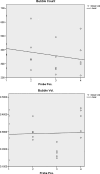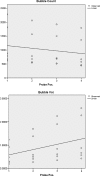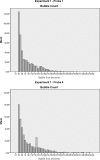The effects of pressure on gases in solution: possible insights to improve microbubble filtration for extracorporeal circulation
- PMID: 23930378
- PMCID: PMC4557586
The effects of pressure on gases in solution: possible insights to improve microbubble filtration for extracorporeal circulation
Abstract
Improvements in micropore arterial line filter designs used for extracorporeal circulation are still needed because microbubbles larger than the rated pore sizes are being detected beyond the filter outlet. Linked to principles governing the function of micropore filters, fluid pressures contained in extracorporeal circuits also influence the behavior of gas bubbles and the extent to which they are carried in a fluid flow. To better understand the relationship between pressure and microbubble behavior, two ex vivo test circuits with and without inline resistance were designed to assess changes in microbubble load with changes in pressure. Ultrasound Doppler probes were used to measure and compare the quality and quantity of microbubbles generated in each test circuit. Analysis of microbubble load was separated into two distinct phases, the time periods during and immediately after bubble generation. Although microbubble number decreased similarly in both test circuits, changes in microbubble volume were significant only in the test circuit with inline resistance. The test circuit with inline resistance also showed a decrease in the rate of volume transferred across each ultrasound Doppler probe and the microbubble number and size range measured in the postbubble generation period. The present research proposes that fluid pressures contained in extracorporeal circuits may be used to affect gases in solution as a possible method to improve microbubble filtration during extracorporeal circulation.
Conflict of interest statement
The author has stated that he has reported no material, financial, or other relationship with any healthcare-related business or other entity whose products or services are discussed in this paper.
Figures












References
-
- Mathis RK, Lin J, Dogal NM, et al. . Evaluation of four pediatric cardiopulmonary bypass circuits in terms of perfusion quality and capturing gaseous microemboli. Perfusion. 2012;27:470–479. - PubMed
-
- Lin J, Dogal NM, Mathis RK, Qiu F, Kunselman A, Ündar A.. Evaluation of Quadrox-i and Capiox FX neonatal oxygenators with integrated arterial filters in eliminating gaseous microemboli and retaining hemodynamic properties during simulated cardiopulmonary bypass. Perfusion. 2012;27:235–243. - PubMed
-
- Salavitabar A, Qiu F, Kunselman A, Ündar A.. Evaluation of the Quadrox-I neonatal oxygenator with an integrated arterial filter. Perfusion. 2010;25:409–415. - PubMed
-
- Qiu F, Peng S, Kunselman A, Ündar A.. Evaluation of Capiox FX05 oxygenator with an integrated arterial filter on trapping gaseous microemboli and pressure drop with open and closed purge line. Artif Organs. 2010;34:1053–1057. - PubMed
MeSH terms
Substances
LinkOut - more resources
Full Text Sources
